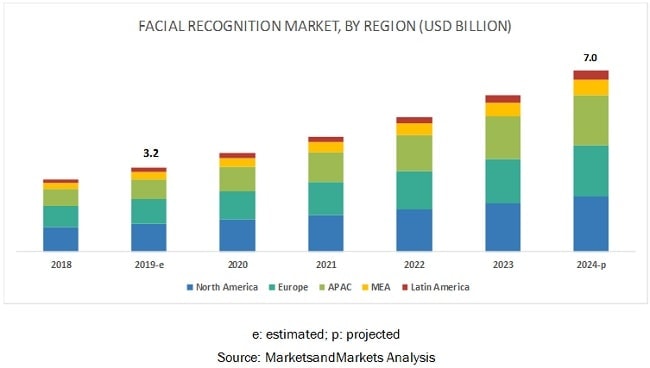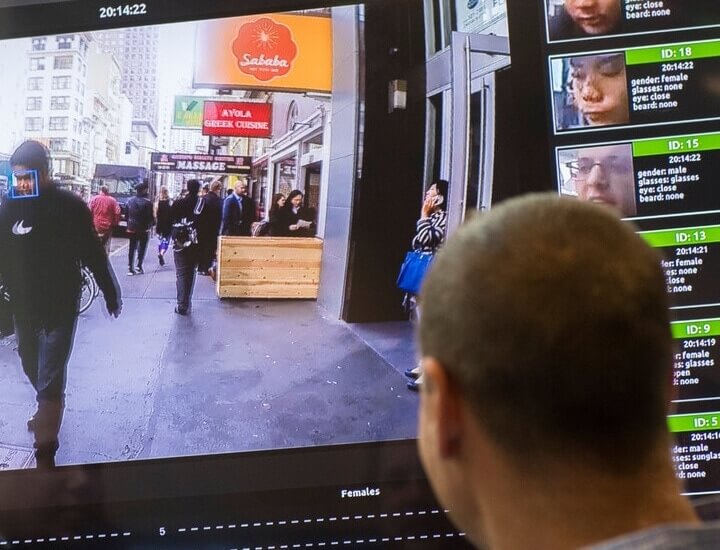
Facial recognition is the technology that helps in verifying, authenticating and authorizing the identity of a person by recognizing their face. Facial recognition works by capturing, analyzing and comparing facial patterns from the person’s face. Facial recognition has established itself as the preferred biometric benchmark. According to a research report in 2019, the current facial recognition market is estimated at $3.2 billion.
It is expected to grow to $7 billion in revenue by 2024. It’s expected to grow at a compound annual growth rate of 16% from 2019 through 2024. The top 3 categories that are the leading consumers of facial recognition are Security (law enforcement), health and marketing and retail.

Companies and governments across the world have adopted facial recognition, among which USA, China and are the leading adopters. Technology companies such as Google and Facebook have invested heavily, furthering their development. Both use this for their respective photo-based apps.
Both Facebook and Google have reached accurate face detection levels of 97.35% and 99.63% respectively. With tech to support it, facial recognition has tremendous opportunities in the fields of Emotion Recognition, Attendance Tracking, and Monitoring, Access Control, Behavioural Analysis, Crime and more.
The surge in the Artificial Intelligence development and Machine Learning (ML) space has propelled the growth of facial recognition’s as key players plan to integrate Artificial Intelligence (AI) and the IoT application development with facial recognition systems. North America holds a significant market share while Europe and the Asia Pacific are expected to grow over the next 5 years.
How does facial recognition work?
You’re either good with faces or not. Well, that’s your memory doing the hard work for you. Let’s find out how facial recognition actually works. Facial recognition is a sophisticated system involving multiple steps, each specializing in a particular task as part of the process.
As a person’s face undergoes several changes during their lifetime, complex facial recognition’s systems consider multiple factors such as ageing, plastic surgery, cosmetics, effects of drug usage or smoking, pose, posture and image quality. All these factors contribute to the overall accuracy of the recognition technology. We can break this process into two logical steps:
- Pre-processing Stage
- Recognition Stage
The Pre-processing stage can be further categorized into:
Face detection and tracking
This is the first step of facial recognition – to detect or identify if the given sample (image/video) has a face(s). It also tracks certain facial features or expressions for future use cases.
Face alignment
Facial recognition technology needs to combat the fact that our faces are not aligned or structured in any particular manner in a sample. The face might be blurred, partially covered with an object like a book, presenting a side profile, which makes detection even trickier. This is the objective of face alignment. It highlights the contouring facial lines and features for a face in the given sample.
Once the Pre-processing is complete, next is the Recognition stage. The Recognition stage comprises of two sub-stages:
Feature extraction
This is the most critical piece of the puzzle. This is where the recognition technology reads the geometry of the face in the sample. It captures individual features such as the eyes, nose, lips, chin, the distance between the eyes, distance from the forehead to the chin and so on. The data is captured in a format that can create a unique facial signature and be consumed by algorithms to perform facial recognition.
Feature matching
Here the system compares the data extracted (mathematical formula of the face) in the previous stage to a known/given database of facial signatures to find a match. The output can be used in several ways, such as Facebook and Google who automatically identify and tag people in your photos.
How facial recognition is disrupting in various industries
Healthcare
Facial recognition has led to the upliftment of several sectors in the healthcare industry and improve overall patient care. It helped to:
- Automate access to medical reports based on facial recognition
- Prevent fraudulent insurance claims
- Streamline patient registration
- Use emotion recognition to detect pain in patients
- Identify diseases that cause detectable changes in appearance
- Listerine has developed a facial recognition system to notify blind people when others are smiling at them with vibration to provide indirect social cues.
Automotive manufacturers
Automobile companies are embedding facial recognition tech. in their vehicles, for driver authentication to improve ease of access and reduce car theft. Cars nowadays feature keyless entries using facial recognition tech.
It can be used to create driver profiles that could store information such as seat and steering position, vehicle speed, preferred music volume, and other such driving preferences. Ford and Intel have developed a product that only allows the owner and designated family members to start the car.
Banking and finance
Security within the banking and finance industries is paramount. Banks such as HSBC, Chase, Bank of America and Apple’s FaceID use facial recognition tech to authenticate customers, log in to the mobile banking apps and perform various transactions.
Companies such as MasterCard have also experimented with this to allow customers to conduct transactions approved by their phone’s camera. CaixaBank, Spain is using a facial recognition system as a signature for ATM cash withdrawals to prevent fraud and eliminate the need for a PIN.
Marketing, advertising, and retail
It’s about making data-driven decisions, targeted marketing and advertising based on a specific user. Facial recognition has helped brands create and maintain individual user profiles that track their online and physical store movements to recommend appropriate shopping options. Beauty brands like MAC allow customers to virtually try on makeup using augmented reality.
Law enforcement
Tech giants such as Amazon and the company are developing facial recognition-driven law enforcement applications. These apps can be used to identify shoplifters and curb organized retail crime.
The Govt. of India issued an Aadhar card for every citizen of India. Agencies use the tech to identify fake passports as well. It’s a unified community for companies and governments to devise solutions to curb terrorism and cybercrime.
Aviation
Airlines are using facial recognition to streamline customer experience with faster check-ins and baggage claims. JetBlue is experimenting with authenticating users via face detection instead of a boarding pass.
Hospitality
Facial recognition tech is a boon to the hospitality industry where hoteliers can personalize their customers’ user experience to suit their needs. Using the guest’s face, the hotel can authenticate its check-in, grant access to rooms and authorized lounges and provide suggestions and perks tailored to each customer.
Insurance
Certain insurance companies are analyzing the face of applicants to provide insurance policy quotes. They take into certain consideration factors such as age, gender, weight, BMI, smoking-related issues and more.
Some Innovative companies using facial recognition
Facebook launched DeepFace in 2014, determining if two faces belonged to the same person. It could detect facial recognition with an accuracy of 97.53%. Facebook uses face recognition auto-suggest people in the pictures you upload on the platform.
Snapchat
Snapchat uses heavy facial recognition that accurately detects your facial contours and features to precisely map the popular Snapchat filters on your face.
Google launched FaceNet in June 2015 which achieved an accuracy of 99.63%. Google uses two separate technologies for images and videos. Cloud Vision is for images and Video Intelligence is for video-based services.
Amazon
Amazon Web Services has a power-packed facial recognition offering in Rekognition. Rekognition provides real-time analysis, extensive facial analysis, scene and activity detection and moderates unsafe content(nudity). Rekognition could identify as many as 100 people in an image.
Apple
Apple recently acquired Emotient, a facial recognition company. Apple’s speculated plan is to perform an emotional analysis with Emotient.
Walmart
Walmart has implemented a facial recognition system that can determine the mood of all customers during shopping and also measure customer satisfaction after visiting the supermarket.
Gemalto
Gemalto is one of the leaders in facial recognition tech and has specialized in the biometric technologies for 30 years. Gemalto’s Live Face Identification System (LFIS) can detect a face in a crowded, dynamic and unstable environment.
Major concerns of facial recognition technology
There are quite a few concerns over the existing and future scope of facial recognition. There are quite a few instances of controversial uses of the tech that raise concerns about human rights and ethics.

Breach of privacy
This is one of the major concerns which divides opinions. For example, a school in China monitors the attention level, mobile usage, etc. of their students.
Lack of regulations
Citizens often see a lack of government policies that explicitly govern the use, misuse, and improper conduct while implementing facial recognition technology.
Lack of accuracy
People are also concerned with the accuracy of facial recognition and whether or not there are any biases. Misidentifying someone of a misdoing would lead to being wrongfully abused by law enforcement.
Lesser control and safety
Once you’re in the database, there’s no coming back. You forfeit the right to who may end up having your profile.
Conclusion
There have been several factors that have contributed to the growth of facial recognition technology, Artificial Intelligence (AI), Machine Learning (ML) and the Internet of Things (IoT) being at its core. The increase of surveillance in the public sector and law enforcement has acted as a driving factor for facial recognition.
People have become tech-savvy (growing use of mobile phones) and vigilant, adding to increased demand for fraud detection and prevention systems.
Governments have also increased security measures for commercial and financial systems using facial recognition. The market for 3D recognition is up for grabs and key players who succeed in integrating Artificial Intelligence (AI) and Machine Learning (ML) with it will be at a clear advantage.
It’s not just about detecting and identifying a person’s face, it also depends on what you do with that information as the possibilities are endless to what you can do. So, get creative and implement recognition to suit your needs.
TechAhead, a leading app development company is known to deliver high quality mobile apps for all platforms and frameworks. Contact our experts now to take your business to the next level.



